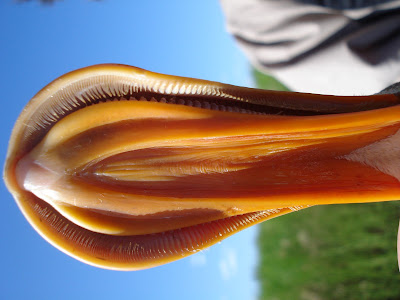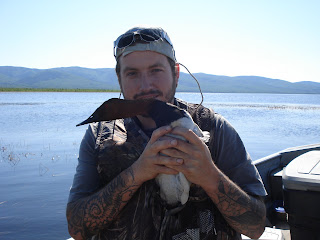
Sloth Bear, Sri Lanka
Last night we had a bear visit camp. Ryan spotted the bear from his tent as it approached camp. When it got close to camp he woke the rest of us up. I was actually listening to the Ting Tings in my headphones when Ryan opens up my tent door and alerts me to the bear. Thank god I wasn't doing anything more intimate! I didn't respond to Ryan's yells, so he had to take a more direct approach. I arrived at the cabin and saw Brandt and Tom outside with shotgun and rifle at the ready, and Ryan with his bear spray. I joined the search party and we jumped in the mud motor, which is a very load weedless boat engine and went down the shore of the lake a hundred meters to where the bear was last seen. Brandt revved the engine to move the bear away. The marsh blue top grass that grows here is about chin high so only Tom standing on the bench was able to see the bear's ears and top of head as it bounded it away. Ryan thinks it was a cinnamon phase black bear a sit was small. However Ryan has no field experience with grizzlies and the Alaska Fish and Game guys, who study pike in the area, saw a small grizzly a few miles away last week. After a little while we returned to bed. We sleep with bear spray and some of us firearms and we keep food and toiletries out of our tens, so we have little to worry about. Although interior Alaska has it's share of bears, we are in the middle of a mosaic of lakes, rivers, bogs, marsh and patches of boreal forest and therefore the bear population is very low.
I was disappointed I didn't see the bear. I've never seen a grizzly or brown bear (same species) and am am really hoping to see one while in Alaska. I've seen polar, black and sloth bears in the wild but as of yet no grizzly. I included a picture of sloth bear I saw in Sri Lanka, as I had no picture of our camp's visitor.
I visited Sri Lanka during my band's second tour of Asia in 2006. We didn't play in Sri Lanks, we just visited there for a week. I arranged a two day safari for the band to Yala National Park. I'll post more about this later... but Yala is an amazing wildlife spectacle. It's on the dry side of Sri Lanka in acacia scrub. It is famous for its leopards and elephants. We had a fantastic trip, seeing 100 species of birds, elephants, sambar and axis deer, wild boar, mongoose, and jackals, after we spotted the slot bear on the side of the road our guide turned around and said, "I have nothing left to show you".
I've seen 3 of the 8 species of bear. Grizzly will put me half way there. Although I doubt I'll ever see the last four. Asiatic Black and Sun bear are hard enough, but from what I understand Panda and Spectacled Bear are almost impossible. I wonder who in the world, if any has seen all eight?



















